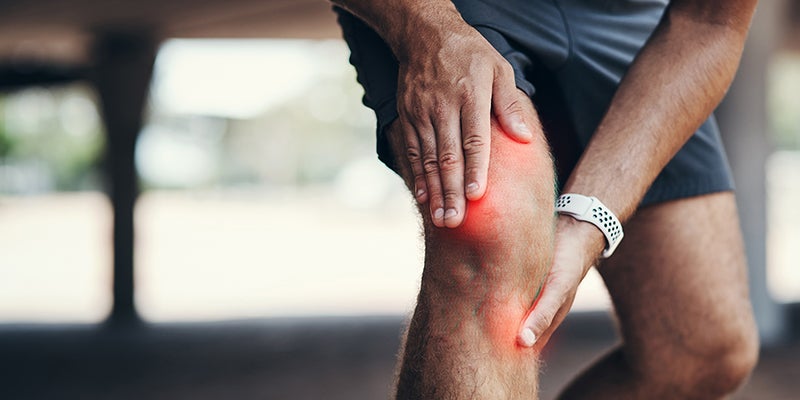FAQ
What is osteoarthritis?
Osteoarthritis is a form of arthritis and a degenerative joint disease characterized by the breakdown and eventual loss of joint cartilage. Cartilage is a protein substance that serves as a cushion between the bones of a joint. Osteoarthritis causes the top layer of cartilage to break down and wears away, allowing bones under the cartilage to rub together.
What causes osteoarthritis of the knee?
Although the root cause of osteoarthritis is unknown, the risk of developing symptomatic osteoarthritis is influenced by multiple factors such as age, gender and inherited traits that can affect the shape and stability of your joints. Other factors can include:
- A previous knee injury
- Repetitive strain on the knee
- Improper joint alignment
- Being overweight
- Exercise or sports-generated stress placed on the knee joints
What are the symptoms of osteoarthritis of the knee?
Symptoms include:
- Pain while standing or walking short distances, climbing up or down stairs, or getting in and out of chairs
- Knee pain with activity
- Start-up pain or stiffness when activities are initiated from a sitting position
- Stiffness in your knee joint after getting out of bed
- Swelling in one or more areas of the knee
- A grating sensation or crunching feeling when you use your knee
How is osteoarthritis of the knee diagnosed?
Your physician will begin by reviewing your medical history and symptoms. He or she will observe the natural movement of your knee, evaluate your knee and ankle joint alignment, and check your reflexes, muscle strength, range of motion and ligament stability in the affected knee. Your physician may order x-rays to determine how much joint or bone damage has been done, how much cartilage has been lost and if there are bone spurs present. Additional medical imaging tests such as computed tomography (CT) or magnetic resonance imaging (MRI) may be ordered to determine exactly where the damage is and its extent. Your physician may also order blood tests to rule out other causes of symptoms or order a joint aspiration which involves drawing fluid from the joint through a needle and examining the fluid under a microscope.
How is osteoarthritis treated non-surgically?
Whether your osteoarthritis is mild or severe, your physician will most likely recommend certain lifestyle changes to reduce stress on your knee joints. Additional disease and pain management strategies may include physical therapy, steroid injections, over-the-counter pain medications such as acetaminophen, nonsteroidal anti-inflammatory drugs (NSAIDs) or topical pain-relieving creams.
When these non-surgical solutions stop controlling symptoms, a patient may be a candidate for surgery.
How is osteoarthritis treated surgically?
The most common surgical knee intervention performed for osteoarthritis is a total knee replacement. During this procedure, the natural joint is removed with the help of Mako SmartRobotics™ System and replaced with an artificial implant. This treatment option is usually offered to patients with advanced osteoarthritis of the knee.
Total knee replacement is not always optimal for patients with early to mid-stage osteoarthritis in just one or two compartments of the knee. For patients with partial osteoarthritis of the knee, a Mako SmartRobotics™ Partial Joint Replacement may be the more appropriate solution.
Mako SmartRobotics™ System and procedures
What is Mako Robotic-Arm Assisted Joint Replacement Surgery?
Mako Robotic-Arm Assisted Joint Replacements are an innovative treatment option for adults living with early, midstage and even severe osteoarthritis. Surgeries are powered by Mako SmartRobotics™ System, which uses 3D CT-scanning to build a digital surgical guide specific to each patient’s anatomy. This allows for consistently reproducible precision in performing partial and total joint replacement surgeries.
During the procedure, the surgeon uses the 3D surgical plan to precisely remove the diseased portion(s) of the knee, sparing the patient's healthy bone and surrounding tissue, making any adjustments as needed. An implant is then secured into the joint which allows the knee to move smoothly again.
How does it work?
The Mako SmartRobotics™ System features three-dimensional pre-surgical planning. During surgery, the system provides the surgeon with real-time visual, tactile and auditory feedback to facilitate optimal joint resurfacing and implant positioning. This technology allows for more accurate positioning of the implant with can result in more natural knee motion following surgery.
What procedures are offered under the Mako SmartRobotics™ System?
Saint Agnes Medical Center currently offers Mako SmartRobotics™ Total Knee Replacement and Mako SmartRobotics™ Partial Knee Replacement procedures for patients suffering from degenerative joint diseases. The surgeon determines which procedure is appropriate for each patient by examining the location and severity of knee pain and degeneration.
A Mako SmartRobotics™ Partial Knee Replacement is performed for patients experiencing early to midstage osteoarthritis and can be completed in one or more knee compartments including the medial (inner), patellofemoral (top) and lateral (outer) compartments.
A Mako SmartRobotics™ Total Knee Replacement involves the complete resurfacing of the knee joint for patients with severe osteoarthritis.
What should I expect from surgery?
What are the benefits?
The Mako Robotic-Arm Assisted Joint Replacement procedures are designed to relieve the pain caused by joint degeneration and potentially offers the following benefits:
- Improved surgical outcomes
- Less implant wear and loosening
- Joint resurfacing
- Bone sparing
- Smaller incision
- Less scarring
- Reduced blood loss
- Minimal hospitalization
- Rapid recovery
Who is a candidate for surgery?
Typically, patients share the following characteristics:
- Knee pain when active
- Start-up knee pain or stiffness when activities are initiated from a sitting position
- Failure to respond to non-surgical treatments or nonsteroidal anti-inflammatory medication
What should I expect?
Mako Robotic-Arm Assisted Joint Replacement can be performed as either an inpatient procedure or on an outpatient basis depending on what your orthopedic surgeon determines is right for you. Hospital stays average anywhere from one to three days while ambulatory patients return home the same day.
In many cases, patients are permitted to walk soon after surgery, drive a car within two weeks and return to normal daily activities shortly thereafter.
What is the lifespan of a joint replacement implant?
All implants have a life expectancy that depends on several factors including the patient's weight, activity level, quality of bone stock and compliance with their physician's orders.
Proper implant alignment and precise positioning during surgery are also very important factors that can improve the life expectancy of an implant. Through the use of Mako SmartRobotics™ System, implants can be optimally aligned and positioned to ensure the longest benefit.

